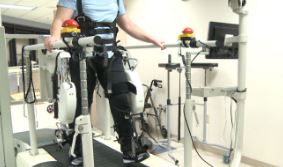
The Lokomat is a system that holds a patient up while using repetitive movements to retrain the brain for walking.
“When conditions are appropriate, and the indications are appropriate, this can actually help fasten their rehab program,” said Staff Physician Dr. Sankar Chirumamilla.
This complex machine can help people who have experienced any neurological injuries.
“Spinal cord, brain injuries, traumatic or non-traumatic brain injury,” Dr. Chirumamilla pointed out. “Strokes, cerebral palsy, sometimes we use it for multiple sclerosis.”
The Lokomat has helped Pikeville Medical Center patients for around 10 years.
Dr. Chirumamilla says it can also help in ways other than walking.
“This also helps not just the quality of life. In some studies, they have shown that this actually what we call spasticity. It helps their bowel and blatter function, patients who have these deficits because of the neurological injuries,” Dr. Chirumamilla explained.
The technology also uses bio-feedback. This is displayed on a monitor in front of the patient featuring a “smiley face” with a small, medium or big “smile.”
Physical therapists can pin-point weaker areas that may need more work based on feedback.
“This times a week to get into this machine. Sweat dripping off of him for minutes per day,” recalled Tipton.
“He had a brain disorder that was not going to get better. It was a progressive disorder, but we improved his quality of life,” Tipton explained. “He was able to walk on a walker after a few treatments and ride on his riding lawnmower which was his ultimate goal.”
Tipton has worked at PMC for more than 22 years.
“Probably 90% of the patients we put in here are from outside of Pike County,” Tipton pointed out.
She said the Lokomat can take the weight off of a patient’s spine by elevating the person. As a response, this also will take the weight off of the legs.
“Once we get them in there, we make sure everything is aligned properly. The knee, hip, and ankle are in the right position,” explained Tipton.
The repetitious movement is important in the rehabilitation process.
“This whole thing is about practice and practice makes perfect in all of our lives,” Tipton said.
The machine at PMC is also equipped to help pediatric patients.
Tipton said the nearest Lokomat with the “pediatric legs,” is located in Cincinnati.
“I had one who was going from using a walker that he had to pull behind him because he had such poor balance. Then, he went to crutches,” Tipton recalled. “Just seeing that little kid be able to go to school on crutches and not on a walker, that’s just rewarding in itself.”
Lokomat is only one technologically advanced piece of equipment used in rehabilitation.
The Armeo Spring is another robotic machine used to help patients regain the use of their limbs.
“The one we have is for upper extremity function and improvements. It helps the patients who had strokes and lost function in their arms and hands,” Dr. Chirumamilla explained.
He said to qualify for the Armeo Spring machine, patients will need to have certain movements in the arm.
“A patient can see visually how much they are progressing,” said Dr. Chirumamilla.
Using what may appear to be a game, it can help movement in the arm, shoulder, elbow and wrist.
If you would like to possibly receive treatment from the Lokomat or Armeo Spring, you will need a referral from your physician and physical therapy evaluation.
The Lokomat can be used in both inpatient and outpatient.



